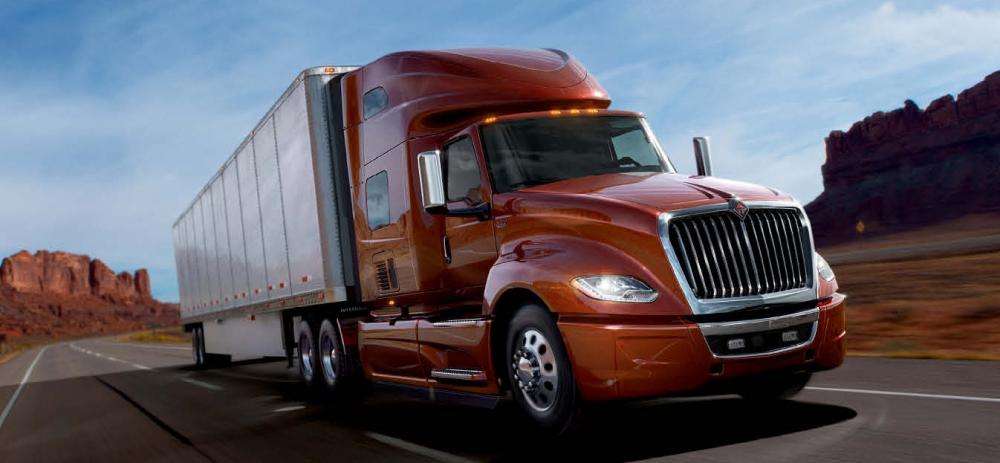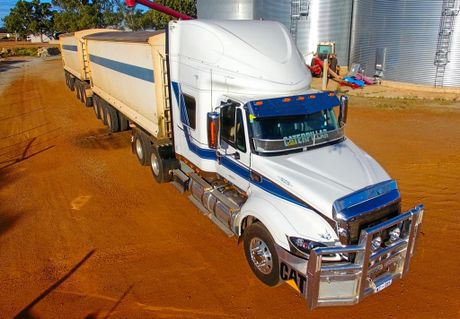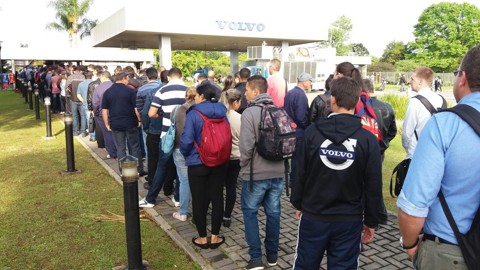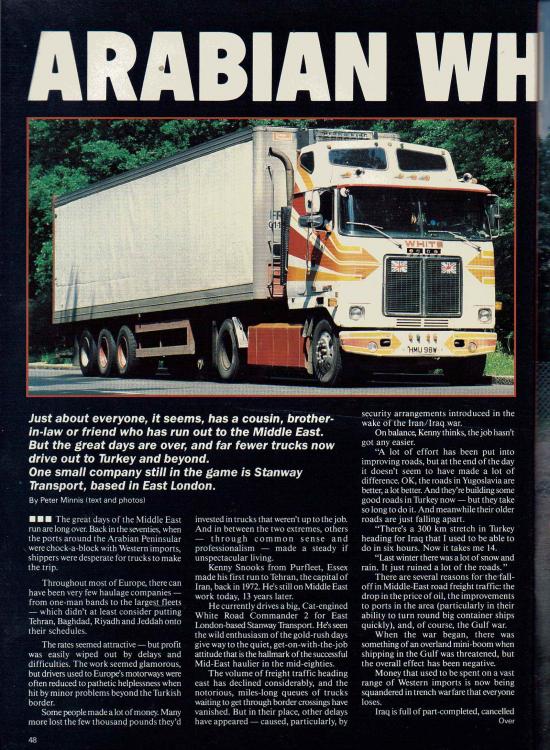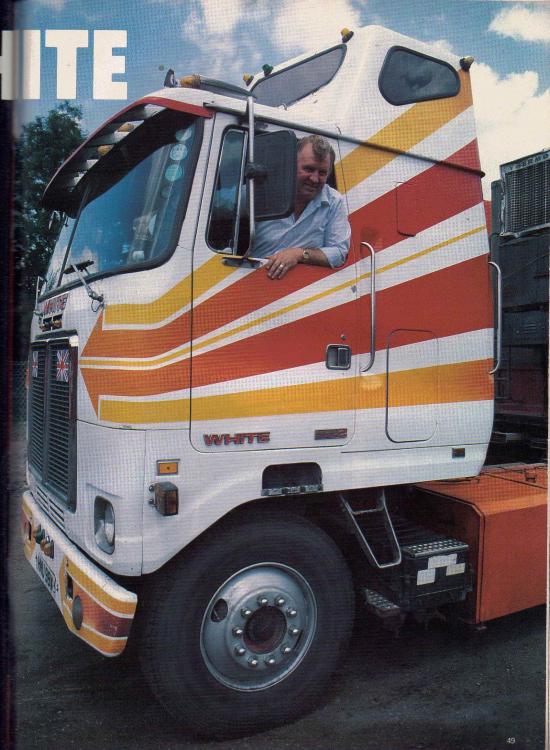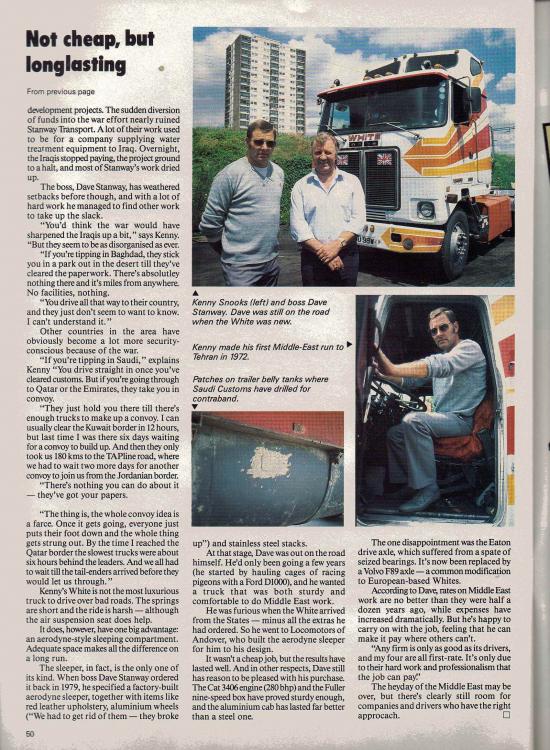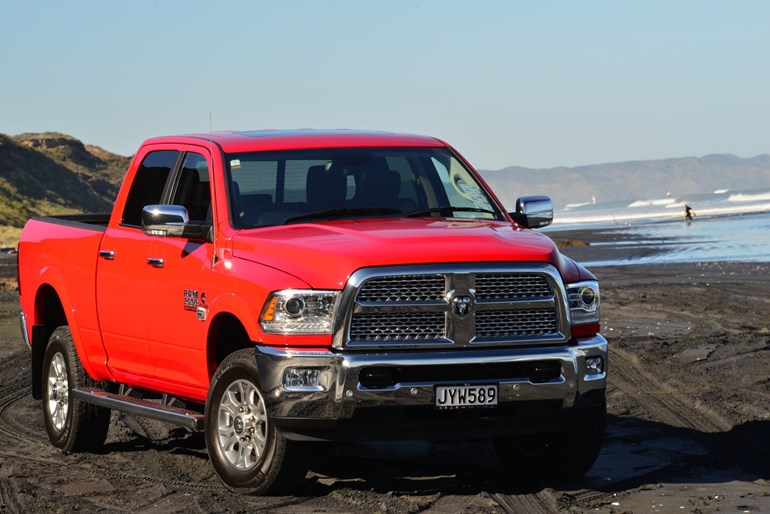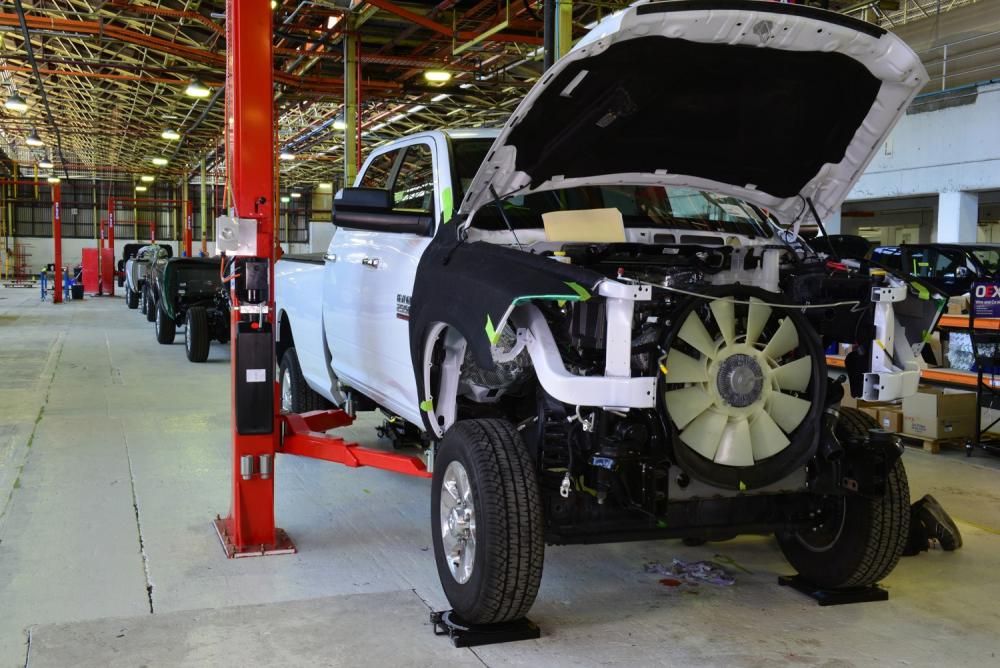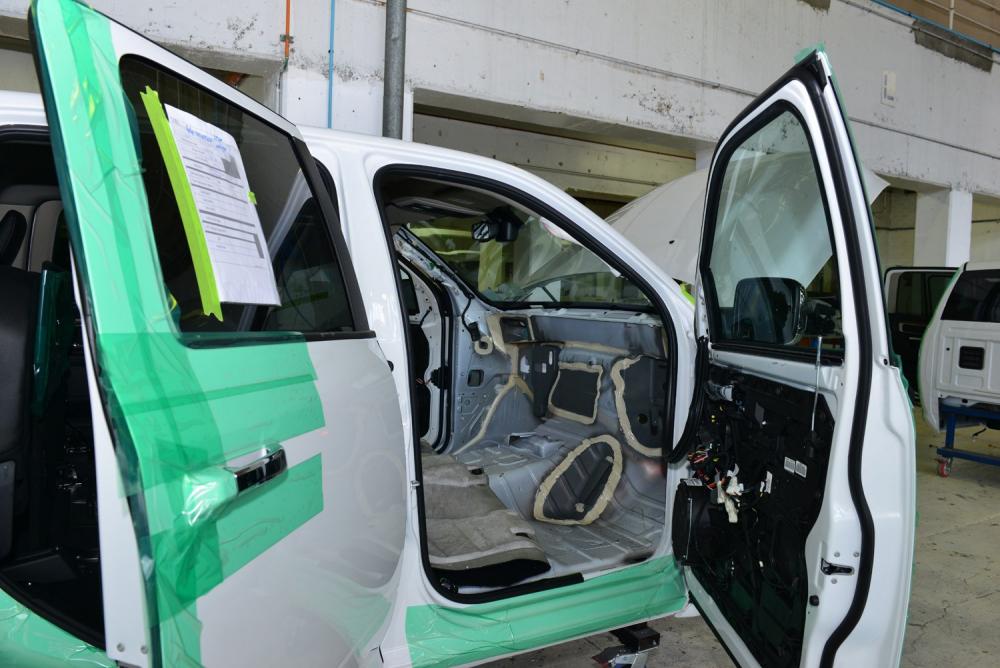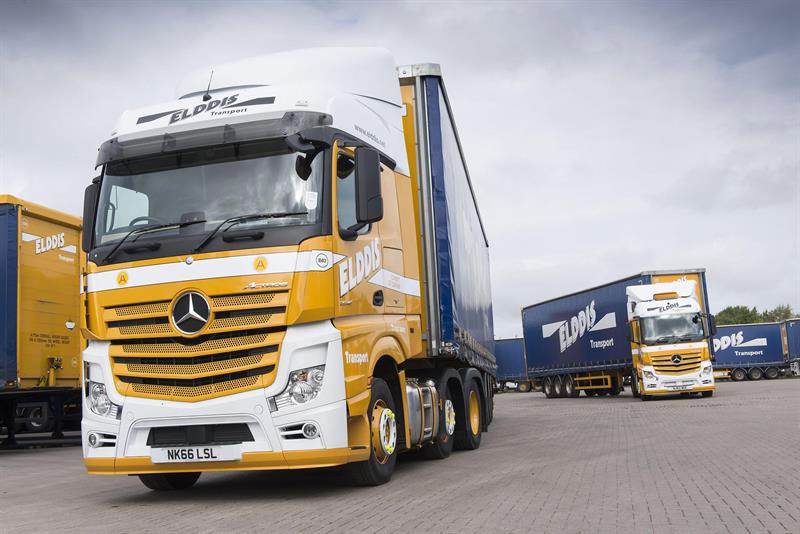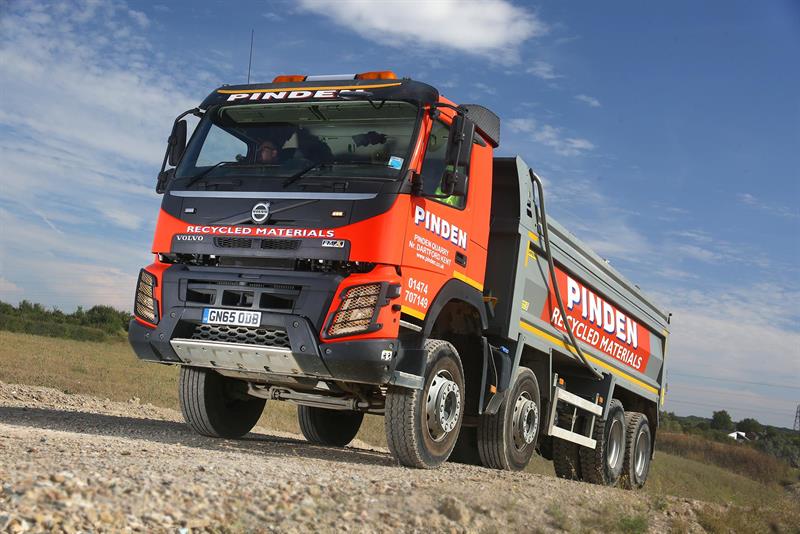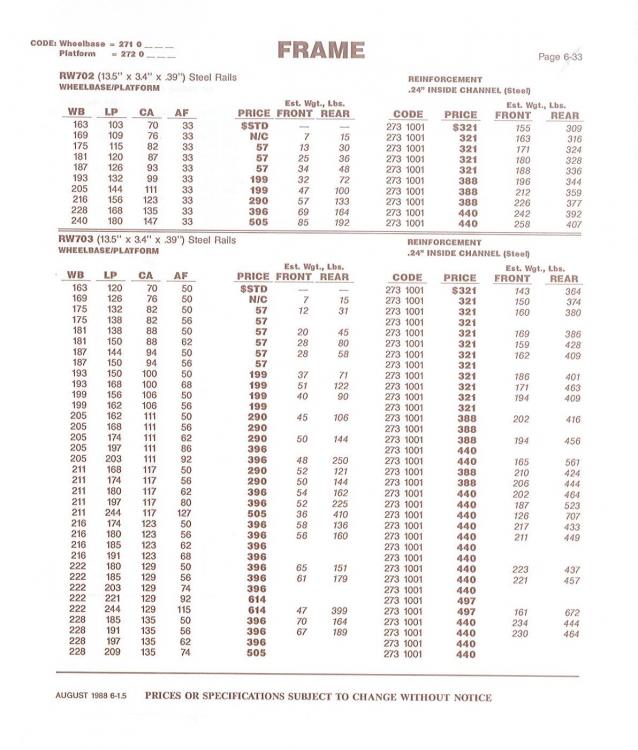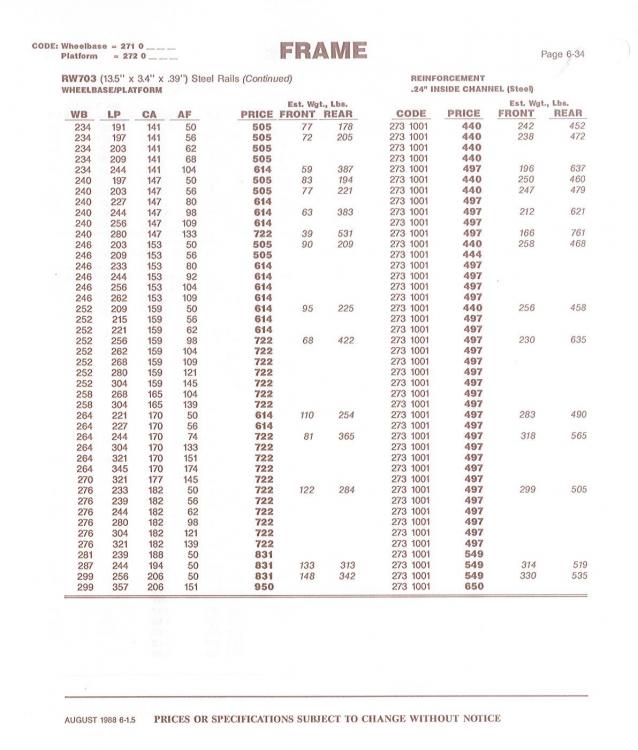
kscarbel2
Moderator-
Posts
18,855 -
Joined
-
Days Won
114
Content Type
Profiles
Forums
Gallery
Events
Blogs
BMT Wiki
Collections
Store
Everything posted by kscarbel2
-
Transport Topics / October 19, 2016 Josh Switkes, President and CEO of Mountain View, California-based truck platooning system designer Peleton Technology, talks about the concept. . .
-
Navistar Simplifies Core Exchange Process Management Heavy Duty Trucking / October 19, 2016 Navistar has launched the Core Advantage Program, which is designed to help fleet owners reduce costs by helping them manage their core and remanufacturing activity. Through new tools like the Navistar Core Management System software, fleets can streamline the process of tracking the turning in of used cores, such as engine blocks. “Core [return] is a key part of the business and the Core Advantage Program demonstrates our commitment to provide the best tools in the industry for our fleet customers and help them reduce their operating costs,” said Joel Larsen, vice president, parts product management, Navistar. “The program will increase our product and service offerings, including Navistar’s private label brand Fleetrite parts and our OnCommand suite of value-added services. A good ‘core return’ program is key to a successful ‘reman’ program.” Cores are employed to remanufacture a returned part and restore it to a “like new” condition. Remanufactured parts have the features and functionality of a new part and come with a warranty. Navistar said that with its Core Advantage Program, fleets can have an account number and location codes within CMS, allowing it to see and run reports on purchases, return history, core eligibility, and core fallout rates across multiple locations. Fleet owners can use the system to answer questions that include: Which locations have the most fallout? Are we buying the correct part? Which core eligibility will expire soon? “The Core Advantage Program was built and designed by Eddie Wessler and his team, who run Navistar’s core operations and have over 100 years of combined experience in remanufacturing and core,” said Chintan Sopariwala, general manager of core and remanufacturing operations, Navistar. “The whole idea is to reduce the burden of managing cores for our customers." To learn more about this program, fleets can contact Navistar Core Operations at 1-800-758-3771 or email corecustomerservice@navistar.com.
-
Fleet Owner / October 19, 2016 Navistar announced the launch of the Core Advantage Program, a new approach for core life cycle management. The Core Advantage Program helps fleet owners reduce their overall costs by helping them to manage their core and remanufacturing activity through new tools like the Navistar proprietary software Core Management System (CMS), Navistar said. Cores are used or failed parts that have been returned by the customer at the end of its product life. “Core is a key part of the business and the Core Advantage Program demonstrates our commitment to provide the best tools in the industry for our fleet customers and help them reduce their operating costs,” said Joel Larsen, vice president, Parts Product Management, Navistar. “The program will increase our product and service offerings, including Navistar’s private label brand Fleetrite parts and our OnCommand suite of value-added services. A good ‘core return’ program is key to a successful ‘reman’ program.” Cores are employed to remanufacture a returned part and restore it to “like new” condition. Remanufactured parts carry the same features and functionality as new parts and come with the same warranty. “Remanufacturing is great for the environment and great for business,” said Chintan Sopariwala, general manager of Core and Remanufacturing Operations, Navistar. “Remanufactured parts offer a low cost alternative to new parts without sacrificing on product quality or warranty. Last year alone, Navistar recycled over 70 million pounds of used truck components and we have even more aggressive plans to increase this number.” With the new Core Advantage Program, fleets can now have their own account number and location codes within CMS, which streamlines their ability to see and run reports on purchases, return history, core eligibility and core fallout rates across multiple locations, according to Navistar. Estes Express Lines Parts Manager Jim Cliborne, who was part of the pilot program, added, “The new program from Navistar has worked well for us. It’s been instrumental in increasing recovery on end-of-life trucks and reducing our maintenance costs.” Sopariwala added, “The Core Advantage Program was built and designed by Eddie Wessler and his team, who run Navistar’s core operations and have over 100 years of combined experience in remanufacturing and core. The whole idea is to reduce the burden of managing cores for our customers and the Core Advantage Program does just that.” Under this new program, Navistar will also work with fleets and end customers to help manage end of life, wrecked trucks, buses and surplus components. To learn more about this program, fleets can contact Navistar Core Operations at 1-800-758-3771 or email corecustomerservice@navistar.com. .
-
I agree, if it's a glider kit. Do you have the MH's model and serial number?
-
Merriam-Webster defines the word arrogance as the "the demeanor of people at Caterpillar, Allison and Paccar".
-
When you called Watt's Mack (provider of the BMT website) at 1-888-304-6225 with your truck's model and serial number located on the vehicle identification plate attached to the driver's door, what did they say ?
-
B Model muffler heat shield
kscarbel2 replied to richard-b61's topic in Antique and Classic Mack Trucks General Discussion
Understood. I'm sorry that my information ended up not being of any help. -
New Caterpillar CEO Faces Tough Decisions as Company Digs Out The Wall Street Journal / October 19, 2016 Jim Umpleby’s first months at the helm could require difficult calls as he cleans up after a bad bet on mining Among Jim Umpleby’s first tasks as Caterpillar Inc. ’s chief executive will be cleaning up the fallout from his predecessor’s expansion plans. Doug Oberhelman, who is leaving the top job at the end of this year after big money investments ran afoul of the global commodities bust, has embarked on a cost cuts aiming to pare 10,000 jobs, $1.5 billion in annual expenses, and up to 20 plants through 2018. Mr. Umpleby will preside in his first months as CEO over a downsizing expected to last through next year. The 58-year-old Caterpillar veteran also faces contract negotiations ahead of a March 1 deadline with the equipment maker’s United Auto Workers union. Those cutbacks and negotiations will set the stage for decisions on how aggressively Caterpillar will chase the next boom in construction and mining, or whether it will narrow the equipment giant’s focus to less-risky projects and higher-profit business lines. Caterpillar’s sales of bulldozers, excavators, mining shovels and huge dump trucks have declined for four consecutive years. Many analysts expect them to fall again in 2017. Caterpillar faces a tougher set of competitors in China and Japan that are ratcheting up product lines and quality in expectation of a market rebound. Since 2013, Mr. Umpleby presided over Caterpillar’s engines business: a low-profile division that recently has been Caterpillar’s most profitable. Engines have accounted for up to two-thirds of the company’s annual operating profit in recent years and 40% of its equipment sales. Identifying pockets of strength in Caterpillar’s cyclical markets likely will define Mr. Umpleby’s tenure, particularly if demand for Caterpillar’s earth-moving and mining equipment remains soft. In its engine business, “they could identify opportunities that are not immediately obvious now,” said Joe O’Dea, an analyst for Vertical Research Partners LLC. Despite 35 years at Caterpillar, Mr. Umpleby isn’t well known at the company’s Peoria, Ill., headquarters because he spent most of his time in San Diego and overseas. His ascent was a surprise to some. Mr. Umpleby wasn’t available for comment. A Caterpillar spokeswoman declined to say whether he would speak with analysts next week after the company releases its third-quarter results. The spokeswoman said Mr. Umpleby will be reviewing the company’s strategy with Caterpillar’s leadership team in coming weeks. “You should expect to hear more about the strategy in early 2017,” she said in an email, noting Messrs. Oberhelman and Umpleby will remain in their current positions through the end of the year. “We’re all focused on finishing the year strong.” Colleagues described Mr. Umpleby, son of a steel mill foreman in Highland, Ind., as a methodical manager and careful listener. Don Ings, a former Caterpillar executive who has known Mr. Umpleby for more than 30 years, said the company’s fortunes may turn up during his tenure. “Doug was dealt a deck of cards,” Mr. Ings said of Mr. Oberhelman. “Jim’s going to be lucky enough that his deck of cards is going to include the upcycle [for machinery] and Caterpillar is very, very-well positioned to achieve greatness during that cycle.” Mr. Umpleby joined Caterpillar in 1981 through its acquisition of Solar Turbines, a subsidiary prized for its high margins. He later served as the San Diego-based business unit’s president. The oil-price decline has damped Solar’s sales recently, but the division hasn’t slipped as much as other units. “Those gas turbines continue to operate on offshore facilities, oil and gas pipelines,” Mr. Umpleby told investors at a conference in August. “We’re pleased with where we are at this point in the year.” Mr. Umpleby will report to Dave Calhoun, an executive at private-equity firm Blackstone Group LP who will replace Mr. Oberhelman as board chairman at the end of March. It is the first time Caterpillar will have a separate chairman and CEO in 26 years. “If I had to pick a chairman of any company that needed turning around, I’d pick Dave,” said Jim Kilts, former Nielsen Holdings chairman when Mr. Calhoun was its CEO.
-
Timmy, did you look for the Mack 4QK part number stamped on the top of the "T" on the main leaf?
-
CAT Operators - Nicoletti (Western Australia)
kscarbel2 replied to kscarbel2's topic in Trucking News
Cat Trucks spearhead grain operation CAT Trucks Australia / Navistar Auspac Press Release / October 21, 2016 CAT Trucks' biggest prime mover, the heavy duty CT630HD, has been chosen to spearhead a large grain operation in Western Australia. As the western harvesting season begins, the 130 tonne road train spec Cat Truck is hauling large payloads of bulk grain in the Nicoletti Group of Company's operations, mostly centred in the heart of the WA wheat belt. Eight Cat Trucks in the combined fleets are meeting the demands of the Nicoletti operation. Principal John Nicoletti says today his family-owned operation is farming around 300,000 acres in the central wheat belt. "We have 40,000 hectares of crop and run 12 harvesters. We have to shift the grain in a hurry because if it gets down-graded it costs us money. You can't get contract trucks at harvest time so we run our own fleet,” Mr Nicoletti says. The Nicoletti business model is vertically integrated, giving full control of the production and marketing process to the Nicolettis, from planting seed stock to marketing on a global scale. Transport is an important link in that complete integration. However Julie Nicoletti says successful vertical integration is not for everybody. "You've got to be big to make it work. To own big trucks you have to have the capability of having (grain) storage so that trucks can work all year round,” Mrs Nicoletti says. The Nicolettis also own and run a chain of agricultural implement dealerships selling and supporting tractor, harvester and the farming machinery required in the wheat belt. Two Cat Trucks run in the dealership operation, including a brand new, second CT630HD that is used on heavy lifts of machinery the length and breadth of Australia. John Nicoletti has been running Cat Trucks for six years. "We bought a couple of the first ones and they have been performing really well. All I can say to you is that if you are happy with something you stick with it. And we are happy with them and they are reasonably priced. They are reliable,” Mr Nicoletti says. Part of the reason for investing in Cat Trucks, John Nicolettis says, is the support fromWestern Australian distributors, WesTrac, and in particular truck salesman Peter Calligaro. "We've been dealing with Peter for a long time, WesTrac does a great job, the trucks are reliable and for what we do, they work well,” he says. The Nicolettis were among the first to embrace the payload advantage of the heavy duty Cat Truck, the CT630HD. "Ninety tonne just doesn't do it any more,” says Mr Nicoletti, "our furthest haul is 150 kilometres. If you're going to haul grain that far, it pays to have three trailers rather than two. So we need a 130 tonne rated truck. It's going really well, we've got no complaints.” WesTrak's Peter Calligaro is excited about the advantages that the heavy duty truck offers operators. "The CT630HD gives us the tonnage we've never been able to claim before with its 131 tonne rating. This truck gives the grain guys the opportunity to be able to utilise the C Train. With the previous 90 tonne ratings, we couldn't get into that field. This truck has been a big asset to us in the West,” says Peter Calligaro. John and Julie Nicoletti started married life in Merredin a generation ago with, as Julie puts it, "Two hundred dollars in our pockets and a dream. John had a dream to have 100 thousand acres and 20 thousand sheep.” The Nicolettis were to go on and quadruple that seemingly unattainable dream to become the biggest grain growers in Australia. In spite of recent 'down sizing' of their property interests, the Nicolettis are still major players in grain growing. As part of the complete integration of the operation, the Nicolettis have invested heavily in grain storage allowing flexibility in working the market and keeping trucks busy throughout most of the year rather than just at harvest time, a period measured in weeks. "We've had good truck drivers over the years and to keep them we need to keep them busy all year round. Grain storage and our trucks work vertically together and we have been delivering grain down to various flour mills around Perth, keeping the whole operation ticketty boo!” . -
Power Torque Magazine / October 2016 Heavy Vehicle Industry Australia (HVIA) has today launched the 50 year anniversary Brisbane Truck Show, to be held at the Brisbane Convention and Exhibition Centre (BCEC) from Thursday 25 to Sunday 28 May 2017. HVIA Chief Executive Brett Wright said the major milestone is a great reflection on the innovation and resilience of the Australian heavy vehicle industry. “The show has come a long way from its humble beginnings when twenty-one truck, trailer and component manufacturers and suppliers came together at Haulmark Trailers’ premises in Rocklea in 1968.” Brett said. “The 2017 Brisbane Truck Show is the fourth that will be held at BCEC, and will feature up to 300 exhibitors displaying the latest trucks, trailers, components, equipment, accessories and technology.” Mr Wright announced a series of new features and improvements for the 50 year anniversary show. “As part of the celebration HVIA will be featuring an innovation, manufacturing and workforce development display on the Plaza level,” Brett said. “Our focus is always on making the event a great experience for visitors and exhibitors. The improvements we’ve made for the 2017 Brisbane Truck Show range from online ticketing to the exhibition layout.” “As previously, visitors can enter BCEC from any of three points however the main foyer entry will no longer interfere with visitors moving between the main halls and the upper floors.” Other innovations and reforms include: VIP ticket holders will gain exclusive show access from 10:00am on Thursday 25th May 2017 with the show opening to the general public from midday. Exhibitors and HVIA members will be able to purchase VIP tickets through the Brisbane Truck Show Exhibitor Portal. The Brisbane Truck Show opening breakfast will commence at 7:30am and run to 9:00am. The breakfast now precedes the official truck manufacturers’ media tour which will run from 9:30am until midday. This will streamline both events and ensure their timing does not conflict. The show awards have been reformed to recognise and reward excellence in innovation, safety and productivity. Attendee registration will be introduced creating opportunities for exhibitors and attendees to more effectively interact during and after the show. Introducing online ticketing for purchase directly from the Brisbane Truck Show website. The popular Apprentice Challenge will now be a truly national event with competitors being represented from each of the HVIA regions including the Eastern Region of Queensland, NSW and ACT; the Southern Region of Victoria, South Australia and Tasmania; and North-western Region of Western Australia and NT. HVIA looks forward to welcoming you to celebrate our 50 year anniversary Brisbane Truck Show, Australia’s premier event, run by industry for industry” Mr Wright said. Exhibitors should contact National Events Manager Noelene Bradley (07) 3376 6266 or visit the show website for further show information. www.brisbanetruckshow.com.au About the Brisbane Truck Show Organised by HVIA, formerly the Commercial Vehicle Industry Association of Queensland, since its inception in 1968, the Brisbane Truck Show is recognised as the premier event for the Australasian transport industry. Originally known as the Queensland Truck Show, the 1968 and 1969 shows were held at Haulmark Trailer’s premises, Ipswich Road, Rocklea and featured twenty-one industry exhibitors. The Show moved to the Rocklea Wool Stores in 1970 and was an annual event until 1979 when the industry decided that the show should run every two years. In 1983 the show relocated to the Royal National Association Showgrounds (RNA) where it remained for almost thirty years before its move to our current home at the world class Brisbane Convention and Exhibition Centre (BCEC). The BCEC was voted 2016 World’s Best Convention Centre by the International Association of Congress Centres (AIPC). The Brisbane Truck Show also plays an important role supporting the Queensland economy. Over its duration, the 2015 Brisbane Truck Show attracted 56.5% of its visitors from outside of Brisbane, whilst 28% of those transited from interstate and 14.5% internationally. Even more impressive is the huge impact the show contributed to the local and State economy, generating: The equivalent of 269 full time employment positions or 18.7 million in paid wages and salaries. Adding an additional expenditure of over 70.1 million dollars in output into the Queensland economy Contributed a boost in the Gross State Product (GSP) of 34.5 million dollars The 2017 show will host up to 300 exhibitors and attracts upwards of 35,000 visitors over the four show days. *About HVIA: Heavy Vehicle Industry Australia (HVIA) represents and advances the interests of the entire industry involved in the design, manufacture, importation, distribution, modification, sale service and repair of on-road vehicles with a gross vehicle mass or aggregate trailer mass over 3.5 tonnes as well as their components equipment and technology. HVIA seeks to work with government and industry stakeholders to promote an innovative and prosperous industry that supports a safe and productive heavy vehicle fleet operating for the benefit of all Australians. .
-
The Australian Trucking Association talks brakes
kscarbel2 replied to kscarbel2's topic in Trucking News
Drivers warned against electronic braking complacency Steve Skinner, Australasian Transport News (ATN) / October 19, 2016 Some are pushing trucks fitted with electronic stability control to the limit, experts say The experts say that electronic braking and stability technologies are about control, rather than absolute stopping distances. They say the technologies are great for already-safe drivers who might encounter a sudden emergency situation, and of course there are plenty of those possibilities with idiot car drivers alone. However advocates of electronic braking acknowledge there is a risk that drivers will become complacent and push the envelope, thinking the technology will save their bacon if they go too hard. "It’s the guy behind the wheel 9 times out of 10 who controls the destiny of the vehicle, not the technology," says the Australian Trucking Association’s Chris Loose. "And what we are tending to find is there is a small group of guys who will drive to the limit of the technology. So by having the technology, it’s fantastic, but physics is physics, it will not save them all the time, we still have to ensure that they have the skills." Isuzu’s Romesh Rodrigo joined Loose in also warning about driver complacency at this year’s Comvec technical conference in Melbourne. Rodrigo says drivers need education in the new electronic wizardry. He says while in some applications there have been less rollovers with stability control, there’s also been more wheel end damage. "The drivers are now just driving to the limit, pushing these vehicles, and there’s a light flashing there but ‘Oh, gee, my truck hasn’t rolled over yet, so that’s a great thing’," says Rodrigo. "But we’re not teaching the drivers that if that light is flashing, if that (ESC) plug falls out, that truck will be on its side." -
Dressed for Success – The Toyota 86 Racing Team’s Hino 700
kscarbel2 replied to kscarbel2's topic in Trucking News
-
Automotive Business / October 18, 2016 A two week long strike which has curtailed Volvo's truck and bus chassis production in Brazil since Tuesday, October 4, has ended. The workers at the plant in Curitiba accepted the offer of reconciliation made by Volvo and voted in secrecy. The workers will each receive a net allowance of R $ 5,000 to offset the increase of only 50% of inflation measured by the INPC, National Index of Consumer Prices. They also agreed to postpone the discussion of the base date for September 2017 and accepted the increase of 9.62% in food stamps (R $ 419 to R $ 460). The strike began because the workers had at first refused the adjustment of 50% of the INPC. Volvo’s Curitiba plant employs about 3,200 workers, with 1,800 in production. According to the union, the plant was producing around 35 heavy trucks, 12 medium trucks and 5 buses every day before the strike. .
-
Peter Minnis, Truck Magazine / 1985 Just about everyone, it seems, has a cousin, brother-in-law or friend who has run out to the Middle East. But the great days are over, and far fewer trucks now drive out to Turkey and beyond. One small company still in the game is Stanway Transport, based in East London. The great days of the Middle East run are long over. Back in the seventies, when the ports of the Arabian Peninsular were chock-a-block with Western imports, shippers were desperate for trucks to make the trip. Throughout most of Europe, there can have been very few haulage companies, from one-man bands to the largest fleets, which didn’t at least consider putting Tehran, Baghdad, Riyadh and Jeddah onto their schedules. The rates seemed attractive, but profit was easily wiped out by delays and difficulties. The work seemed glamorous, but drivers used to Europe’s motorways were often reduced to pathetic helplessness when hit by minor problems beyond the Turkish border. Some people made a lot of money. Many more lost the few thousand pounds they’d invested in trucks that weren’t up to the job. And in between the two extremes, others, through common sense and professionalism, made a steady if unspectacular living. Kenny Snooks from Purfleet, Essex made his first run to Tehran, the capital of Iran, back in 1972. He’s still on Middle East work today, 13 years later. He currently drives a big Cat-engined White Road Commander 2 for East London-based Stanway Transport. He’s seen the wild enthusiasm of the gold-rush days give way to the quiet, get-on-with-the-job attitude that is the hallmark of the successful Mid-East haulier in the mid-eighties. The volume of freight traffic heading east has declined considerably, and the notorious, miles-long queues of trucks waiting to get through border crossings have vanished. But in their place, other delays have appeared, caused, particularly, by security arrangements introduced in the wake of the Iran/Iraq war. On balance, Kenny thinks, the job hasn’t got any easier. “A lot of effort has been put into improving roads, but at the end of the day, it doesn’t seem to have made a lot of difference. Okay, the roads in Yugoslavia are better, a lot better. And they’re building some good roads in Turkey now, but they take so long to do it. And meanwhile, their older roads are just falling apart.” “There’s a 300 kilometer stretch in Turkey heading for Iraq that I used to be able to do in six hours. Now it takes me 14.” “Last winter, there was a lot of snow and rain. It just ruined a lot of the roads.” There are several reasons for the falloff in Middle East road freight traffic; the drop in the price of oil, the improvements to ports in the area (particularly in their ability to turn round big container ships quickly), and, of course, the Gulf war. When the war began, there was something of an overland mini-boom when shipping in the Gulf was threatened, but the overall effect has been negative. Money that used to be spent on a vast range of Western imports is now being squandered in trench warfare that everyone loses. Iraq is full of part-completed, cancelled development projects. The sudden diversion of funds into the war effort nearly ruined Stanway Transport. A lot of their work used to be for a company supplying water treatment equipment to Iraq. Overnight, the Iraqis stopped paying, the project ground to a halt, and most of Stanway’s work dried up. The boss, Dave Stanway, has weathered setbacks before though, and with a lot of hard work he managed to find other work to take up the slack. “You’d think the war would have sharpened the Iraqis up a bit,” says Kenny. “But they seem to be as disorganized as ever.” “If you’re tipping in Baghdad, they stick you in a park out in the desert till they’ve cleared the paperwork. There’s absolutely nothing there and it’s miles from anywhere. No facilities, nothing.” “You drive all that way to their country, and they just don’t seem to want to know. I can’t understand it.” Other countries in the area have obviously become a lot more security-conscious because of the war. “If you’re tipping in Saudi.” Explains Kenny, “you drive straight in once you’ve cleared customs. But if you’re going through to Qatar or the Emirates, they take you in convoy.” “They just hold you there till there’s enough trucks to make up a convoy. I can usually clear the Kuwait border in 12 hours, but last time I was there six days waiting for a convoy to build up. And then they only took us 180 kilometers to the TAPline road, where we had to wait two more days for another convoy to join us from the Jordanian border. There’s nothing you can do about it - they’ve got your papers.” “The thing is, the whole convoy idea is a farce. Once it gets going, everyone just puts their foot down and the whole thing gets strung out. By the time I reached the Qatar border, the slowest trucks were about six hours behind the leaders. And we all had to wait till the tail-enders arrived before they would let us through.” Kenny’s White is not the most luxurious to drive over bad roads. The springs are short and the ride is harsh, although the air suspension seat does help. It does, however, have one big advantage: the aerodyne-style sleeping compartment. Adequate space makes all the difference on a long run. The sleeper, in fact, is the only one of its kind. When boss Dave Stanway ordered it back in 1979, he specified a factory-built aerodyne sleeper, together with items like red leather upholstery, aluminium wheels (“We had to get rid of them – they broke up”) and stainless steel stacks. At that stage, Dave was out on the road himself. He’d only been going a few years (he started by hauling cages of racing pigeons with a Ford D1000), and he wanted a truck that was both sturdy and comfortable to do Middle East work. He was furious was the White arrived from the States – minus all the extras he had ordered. So he went to Locomotors of Andover, who built the aerodyne sleeper for him to his design. It wasn’t a cheap job, but the results have lasted well. And in other respects, Dave still has reason to be pleased with his purchase. The Cat 3406 engine (280 bhp) and the Fuller nine-speed box have proved sturdy enough, and the aluminium cab has lasted far better than a steel one. The one disappointment was the Eaton drive axle, which suffered from a spate of seized bearings. It’s now been replaced by a Volvo F89 axle – a common modification to European-based Whites. According to Dave, rates on Middle East work are no better than they were half a dozen years ago, while expenses have increased dramatically. But he’s happy to carry on with the job, feeling that he can make it pay where others can’t. “Any firm is only as good as its drivers, and my four are all first-rate. It’s only due to their hard work and professionalism that the job can pay.” The heyday of the Middle East may be over, but there’s clearly still room for companies and drivers who have the right approach. .
-
The Washington Post / October 18, 2016 Last month, the Obama administration announced an eye-popping $38 billion security assistance deal with the Israelis, to be disbursed over ten years starting in 2019. That caught us off-guard. It seemed like a ton of money. But as we looked into the deal, and others like it, we began to realize how little we knew about the U.S. government’s assistance budget, which ranges from programs combating HIV/AIDS to those directly funding other nations’ armed forces. Using the State Department’s request to Congress for a 2017 budget, we compiled what we thought was a comprehensive look at the U.S. foreign assistance budget. That budget request is a complex stew of programmatic acronyms, thickened by confounding numerical overlaps and an endless roster of government agencies. You can see that first attempt here. In response, numerous representatives of those same agencies, as well as academics and analysts, got in touch. “You guys are on the right track,” they said, “but there’s much more to this than you’ve got here.” We hope what follows can stand as a more exhaustive explanation. At the top of this page, you’ll see what a tiny fraction of the entire federal budget is devoted to foreign assistance — just about 1 percent. As we pointed out in the previous post, most Americans vastly overestimate this number in surveys. In a Kaiser Family Foundation study published in early 2015, the average respondent thought that 26 percent of the federal budget went to foreign aid. Unsurprisingly, more than half the respondents thought the United States was spending too much on foreign aid. In the breakdown above, we have laid out where the $42.4 billion will go in 2017. The money comes from the State and Defense departments and a slew of other agencies. But it would be wrong to think that “security assistance” comes entirely from the DoD. Security assistance is a broader term than so-called military aid because this financial support is often extended to other types of security forces such as anti-narcotic or trafficking units. [The money comes from American taxpayers] Actually, only about half the security assistance budget is provided by the DoD. That mostly derives from programs directly tied to military operations in Afghanistan and Iraq, such as the Afghan Security Forces Fund and the Iraq Train and Equip Fund. Deals like last month’s with Israel, on the other hand, come from the State Department. In that case, the U.S. government is essentially financing Israel’s military purchases. Under the current agreement, Israel can spend 26 percent of that money on military equipment produced in Israel, but the new deal, which starts in 2019, gradually phases out that stipulation. Then, like every other country, Israel will have to spend all the assistance money on American defense contractors. In other words, U.S. foreign military financing is essentially a way of subsidizing its domestic defense industry while strengthening the military capabilities of its strategic allies. Economic and development assistance is almost entirely provided through the State Department’s budget. This includes the budgets for the U.S. Agency for International Development (USAID) and Peace Corps, reserve funds for disaster relief, funds geared toward specific objectives, such as preventing the spread of HIV/AIDS, and bilateral economic assistance packages. This is the first of three cartograms, which is a fancy word for a map specifically geared toward a comparative display of statistics. Since American economic and development assistance is spread out among more than 100 countries, the cartogram vaguely resembles a normal map. Nevertheless, seven African countries feature among the top-10 recipients of economic assistance. Most of the money given to those countries is funneled toward health initiatives, particularly HIV/AIDS treatment and research. The biggest recipient, however, is Afghanistan, where the United States is hoping to win over hearts and minds with all kinds of development assistance after 15 years of military quagmire there. As opposed to the broad dispersal of economic development funds, the security assistance cartogram demonstrates the targeted nature of the American national military strategy. A swath of countries from Egypt to Pakistan — excluding Iran, of course — receive the vast majority of U.S. security assistance. The biggest individual, non-bilateral program in the security assistance budget is the Afghanistan Security Forces Fund (ASFF). The DoD describes the program thusly: “For DoD to provide assistance to the security forces of Afghanistan to include the provision of equipment, supplies, services, training, facility and infrastructure repair, renovation and construction, and funding.” Security Assistance Monitor, the nonprofit organization that provided much of the data on which this article is based, says on its website that the ASFF’s ultimate goal “is to produce an independent, self-sufficient armed forces for Afghanistan.” The security assistance budget also includes “train and equip funds” for allied forces in Iraq and Syria. Those funds go toward the Iraqi army, as well as Kurdish peshmerga troops and other militias the U.S. cooperates with in both countries in its push against the Islamic State. Israel and Egypt are the biggest recipients of U.S. military financing. Israel receives about $3.1 billion in annual financing currently, and that number will increase to $3.8 billion after 2017. Egypt has received major financing ever since it agreed to an American-brokered peace with Israel in the Camp David Accords of 1978. Put all together, the top-10 list of U.S. foreign assistance recipients are as follows: (image 5) But if the U.S. assistance budget demonstrates where the American government has strategic interest, then where are some of our biggest allies on the cartograms above? Saudi Arabia, NATO members, Japan, South Korea and India are all conspicuously absent. The answer is that those countries simply buy arms from the United States rather than receive large-scale assistance. Many have their own established defense programs. The cartogram below shows U.S. arms deliveries worldwide for 2015, which amounted to $21.9 billion. The U.S. sells arms to nations that surround its main adversaries, China and Russia, as well as to countries playing active roles in the ongoing conflicts in the Middle East, which includes most of the Gulf states. The massive scale of assistance the United States provides to nations around the world is a reflection of its ubiquitous presence on the world stage, and the sheer size of its economy. The United States provides far more assistance than any other country in the world, and in terms of arms sales, it controls at least half the global market. However, the United States gives less as a percentage of its gross national income than other countries. U.N. resolutions have set 0.7 percent of GNI as an unofficial benchmark that developed countries should contribute to foreign assistance. According to 2015 OECD statistics, the U.S. contributes about 0.17 percent of its GNI, which is below the 0.3 percent that is the average for developed nations. Only six countries, all in Europe, have reached the U.N. benchmark: the United Kingdom, the Netherlands, Denmark, Luxembourg, Norway and Sweden. Sweden stands out, contributing almost 1.4 percent of its GNI to foreign assistance. Data - https://www.washingtonpost.com/graphics/world/which-countries-get-the-most-foreign-aid/?hpid=hp_hp-more-top-stories_foreign-budget-655pm%3Ahomepage%2Fstory
-
"People should and do trust me" - Hillary Clinton
kscarbel2 replied to kscarbel2's topic in Odds and Ends
Leaked emails reveal how Clinton world spins The Financial Times / October 18, 2016 Hacked messages show how aides sought to insulate Democratic nominee from attack Hillary Clinton’s aides were worried about how the Clintons’ ties to foreign lobbyists and Wall Street banks might hurt her, and did their best to insulate her from any fallout — even when Mrs Clinton herself did not realise they were a problem. This is one of the revelations inside more than 17,000 hacked emails of Clinton campaign chairman John Podesta, which have been released by WikiLeaks over the past week and a half in 11 separate data dumps. An additional 33,000 emails are still expected to be released by WikiLeaks before election day. The slow release of the emails has added to the impression that Mrs Clinton is dogged by the same issues that have followed her since the primary, and contributed to the impression that the candidate is a different person behind closed doors than in public. According to a CBS News poll released on Tuesday, only one in three voters thinks that Mrs Clinton believes what she is saying, versus two in three voters who think she says what people want to hear. In contrast, nearly three in five voters think that Mr Trump does believe what he is saying, even though Mrs Clinton leads him by 11 points nationally. Here is what we have learnt from the hacked emails and what they say about how Mrs Clinton’s world operates. • The line between ‘good’ and ‘bad’ Clinton donors is not always clear — even to the Clintons In an April 2015 email chain, Clinton aides deliberated over whether it was a good idea to accept campaign donations from lobbyists who worked on behalf of foreign governments. Robby Mook, Mrs Clinton’s campaign manager, initially argued against the idea, saying it was too hard to come up with a system to determine which foreign governments were deemed acceptable to lobby (ie. Canada) and which were not. While he and other aides at one point talked about vetting lobbyists on a case-by-case basis, Mr Mook was eventually persuaded to change his mind, with others arguing that lobbying for a foreign government was in some cases no worse than lobbying for a controversial US corporation, such as Philip Morris. “In a complete U-turn, I’m OK just taking the money and dealing with any attacks,” Mr Mook wrote. Jennifer Palmieri, Mrs Clinton’s director of communications, agreed. “Take the money!!” she urged. • The Clinton campaign tried to move the Illinois primary In a different email chain with Mr Podesta, Mr Mook suggested that the Clinton campaign should try to convince the Illinois legislature to delay the state’s primary by at least a month, a move he suggested would help make sure the Republican party was stuck with a more extreme nominee who would fare worse in the general election. “The overall goal is to move the [Illinois] primary out of mid-March, where they are currently a lifeline to a more moderate Republican candidate after the mostly southern Super Tuesday,” Mr Mook wrote in November 2014. Mr Mook suggested that Mr Podesta should contact Bill Daley, a fellow Obama administration alumnus, to see if he could convince the Illinois House speaker to move the date of the primary, and emphasise that it was a “Hillary ask”, not an “Obama ask”. “The Clintons won’t forget what their friends have done for them,” Mr Mook wrote. The primary date was never moved. • At times, aides thought it best that Mrs Clinton be left in the dark In the weeks before Mrs Clinton announced that she would be running for president, aides worried that former President Bill Clinton was continuing to accept large speaking fees from financial institutions, something they correctly assessed might become an issue during the Democratic primary. Mrs Clinton, however, was insistent: her husband should continue to give the speeches and accept the large fees. In an email to Mrs Clinton’s top aide Huma Abedin, Mr Mook laid out why he believed Mrs Clinton was wrong. “I know this is not the answer she wants, but I feel very strongly that doing the speech is a mistake,” Mr Mook wrote. After he and other campaign aides went ahead and cancelled a planned Morgan Stanley speech by Mr Clinton, Ms Abedin said that she would have to tell Mrs Clinton that the speech had been cancelled by Mr Clinton himself, and not the aides, in order not to upset her boss. “HRC very strongly did not want him to cancel that particular speech,” Ms Abedin wrote, using Mrs Clinton’s initials. “I will have to tell her that [former president Clinton] chose to cancel it, not that we asked.” • Mrs Clinton is not as anti-fracking as might seem In a conversation with the building trade union last year, Mrs Clinton suggested that she was significantly more sympathetic to the fracking and fossil fuels industries than she had stressed during the Democratic primary. According to a transcript of that meeting, which was included in Mr Podesta’s emails, Mrs Clinton told the group that she wanted to “defend natural gas”. “I want to defend repairing and building the pipelines we need to fuel our economy. I want do defend fracking under the right circumstances,” she said. Despite a $30bn pledge to revive Appalachia the Democratic nominee is struggling She added that she had little sympathy for “the most radical environmentalists” who were backing her primary rival Bernie Sanders. “They come to my rallies and they yell at me, and you know, all the rest of it. They say: ‘Will you promise never to take any fossil fuels out of the earth ever again?’ No. I won’t promise that. Get a life, you know,” Mrs Clinton said, according to the email. • Tim Kaine was not a shoo-in for VP In an email on March 17, a group of Mrs Clinton’s top aides sent the candidate a long list of 40 names for Mrs Clinton to choose from for her running mate. To make it easier for Mrs Clinton to navigate, they divided the candidates into what appear to be six distinct categories: Latinos, women, white men, African-Americans, military officials and business executives. Bernie Sanders, Mrs Clinton’s primary rival, was placed in a seventh category all of his own. In addition to Mr Sanders and Mr Kaine, the campaign was also looking at a few more unconventional choices, among them Bill and Melinda Gates, former New York mayor Michael Bloomberg, Apple’s Tim Cook and Howard Schultz of Starbucks. . -
"People should and do trust me" - Hillary Clinton
kscarbel2 replied to kscarbel2's topic in Odds and Ends
A Soap Opera in progress __________________________________________________________________________________________________ Wikileaks / October 18, 2016 Wikileaks has revealed that Chelsea Clinton accused some of her father's closest aides of taking 'significant sums of money' from her parents, among other allegations, in an email to members of the Clintons' inner circle. In an e-mail dated November 4, 2011, Chelsea accused Bill Clinton's aides Doug Band, Justin Cooper and Hannah Rickert of corruption, and articulated a number of transgressions, which she described as “very sad.” No fan of Chelsea Clinton, Bill Clinton aide Doug Band described Chelsea in a hacked John Podesta e-mail as “a spoiled brat kid.” The new exchange, which occurred several days before, sheds light on the activities of Band and other aides that made Chelsea Clinton suspicious that they were harming the Clinton Foundation, which she had started to take control of, to enrich themselves. Chelsea Clinton was writing to Podesta, now acting as her mother’s campaign chairman, and Cheryl Mills, Hillary’s State Department chief of staff, along with Victoria Bjorklund and Jennifer Reynoso, two lawyers from the firm Simpson Thacher, who were conducting a Clinton Foundation review, which had commenced the month before. In the e-mail, Chelsea Clinton listed the issues she had been told of or experienced that past week. Her complaints began with Band, who she said had contacted her father's speakers bureau, asking for information about how much he was paid for speeches and how many he delivered. Band then told the bureau he was Bill Clinton's primary contact for booking and not the ex-president's scheduler. Chelsea Clinton then noted that her assistant Ilya Aspis caught Justin Cooper “reading his [Blackberry] and loading the same spyware onto his computer that he loaded onto Bari [Lurie's] computer”. A Secret Service agent told Chelsea Clinton's husband Marc Mezvinsky that Cooper had “asked another Secret Service agent to lie about the parking pass absurdity,” she said, adding, “we can talk about this really ridiculous anecdote offline.” Multiple people reported to Chelsea Clinton that Cooper had been bad-mouthing her father: “in very derogatory ways sadly.” Another aide complained that Cooper had been reading his emails. Chelsea Clinton wrote that her father was told of Band and his firm Teneo pushing for free memberships, using Clinton connections. Band's firm was also “hustling” for business at the annual Clinton Global Initiative (CGI), part of the Clinton Foundation where people and companies make commitments to help solve global problems. “And of people now having quit at CGI - that Doug told Jon Davidson he was never going to forgive him for not reporting that Dad met with John [Podesta] on Sunday and that how could Jon forget who he really worked for,” Chelsea Clinton wrote. Band threatened Bill Clinton's scheduler. “Doug told Terry Krinivic she would never work again in this town if she didn't back him up on everything,” Chelsea Clinton wrote. [Chelsea Clinton’s assistant] “Ilya [Aspis]] believes Hannah and Justin have taken significant sums of money from my parents personally, some in expenses, cars, etc.,and others directly,' she wrote. ----------------------------------------------------------------------------------------------------------------------------- From:aj66@nyu.edu (Chelsea Clinton) To: john.podesta@gmail.com, cheryl.mills@gmail.com, vbjorklund@stblaw.com, jreynoso@stblaw.com Date: 2011-11-04 19:08 Subject: Hello John, Cheryl, Victoria and Jennifer – Although I continue to respond to people's sharing of their concerns about the [Clinton] Foundation and/or my father's world by telling them that 1) I hope they will share their experiences/concerns/hopes/fears with Victoria and her team candidly and 2) that it is critical that as we move to professionalize the Foundation for the future that professionalism starts with this process - people continue to share things with me. Although I continue to not respond or engage beyond what I outlined above, I do think - and my mother strongly agreed as a lawyer - that I should pass along to you Victoria and your team and to you John and Cheryl the below as more information (factual or suspected or imagined). Particularly in advance of what I understand will be an intermediate conversation with Doug tomorrow. I continue to want - and to try - to disintermediate myself from this muddle, edify the corporate audit and existential process we are in - while also being a responsible board member, daughter and person. In that vein, I was told or experienced the following since we had our meeting last week Victoria: - today that Doug reached out to someone at Harry Walker (who represents my father on all speaking arrangements), to ask for a full list of all his speeches, how much he was paid for each speech, and told the contact person at Harry Walker that all speeches should now go through him, not Terry Krinivic (the scheduler) - that Ilya physically saw/caught Justin a couple of days ago reading his bberry and loading the same spyware onto his computer that he loaded onto Bari's computer - a secret service agent told Marc (my husband) that Justin had asked another secret service agent to lie about the parking pass absurdity [we can talk about this really ridiculous anecdote offline] - multiple people shared with me how upset they were at hearing how Justin referred to my father in the last week - in very derogatory ways - Oscar told my father he knows Justin reads his emails - my father was told today of explicit examples at CGI of Doug/ Teneo pushing for - and receiving - free memberships - and of multiple examples of Teneo 'hustling' business at CGI - and of people now having quit at CGI - that Doug told Jon Davidson he was never going to forgive him for not reporting that Dad met with John (ie you John) on Sunday and that how could Jon forget who he really worked for - Doug told Terry Krinivic she would never work again in this town if she didn't back him up on everything. - Ilya believes Hannah and Justin have taken significant sums of money from my parents personally - some in expenses - cars, etc. - and others directly. As ever, on some of the above I am sure there are three sides as my grandmother would say - his, hers and the truth. On others, it seems more clear. All of it makes me very sad. Thank you all for your help. The only people I am sharing the above with are you, my mother and my father. Please let me know as ever if you have any questions or advice. Thank you, Chelsea -
OOIDA to House Approps: Don't mandate speed limiters Greg Grisolano, Land Line (OOIDA) / October 18, 2016 After making a similar request of the Senate, the Owner-Operator Independent Drivers Association is asking the House Appropriations committee to ditch language from an upcoming bill that would force a final rule mandating speed limiters. The Association issued a letter on Oct. 17 to the committee’s chair, Rep. Hal Rogers, R-Ky., and ranking member Rep. Nita Lowey, D-N.Y. The letter also went to chairman of the subcommittee on Transportation, Housing and Urban Development Rep. Mario Diaz-Balart, R-Fla., and ranking subcommittee member Rep. David Price, D-N.C. A provision is included in Section 142 of the Senate Amendment to the FY 2017 Military Construction, Veterans Affairs and Related Agencies Appropriations Act, that requires the Secretary of Transportation to issue a final rule mandating speed limiters. OOIDA’s full letter can be viewed here. The Association issued a similar letter to the Senate Appropriations committee on Sept. 21. “Professional drivers have long opposed efforts to mandate the installation of speed limiters on heavy vehicles because research indicates the technology actually reduces safety for all highway users,” OOIDA Executive Vice President Todd Spencer wrote in the letter. “Truckers across the country encourage members of Congress to oppose the inclusion of Section 142 of the Senate amendment in any final appropriations measure funding the Department of Transportation through the remainder of the fiscal year.” OOIDA opposes a government mandate on this issue, pointing to research that contradicts the fed’s claimed “safety benefits” of speed limiters, as it would force a speed differential between heavy trucks and other vehicles using the highways. That would lead to more vehicle interactions, unsafe maneuvering and crashes, a study of speed differentials shows. On Sept. 7, the Federal Motor Carrier Safety Administration and the National Highway Traffic Safety Administration published a notice of proposed rulemaking on the speed limiter issue. The proposal has drawn criticism from OOIDA and other groups for failing to state how the proposal would decrease crashes overall. Additionally, by the agencies’ own admission, the proposed rule would have an overwhelmingly negative benefit on small-business truckers and owner-operators. Spencer noted that approximately 93 percent of all trucks on the road are operated by small businesses, which maintain 20 or fewer vehicles. “Forcing the agencies’ hand in issuing a mandate without fully considering these consequences would disregard the very serious threat this rule poses to the livelihood and survival of countless small-businesses, which comprise an overwhelmingly large portion of the trucking industry,” he wrote. The proposed rulemaking that would require speed limiters be installed in every new vehicle weighing 26,000 pounds or more. A 60-day comment period on the proposal began Sept. 7. Various industry groups have raised alarm at the proposal, with OOIDA filing a formal request for an additional 60-day comment period. The American Trucking Associations is also calling for a 30-day extension on the comment period. In the letter, Spencer notes that mandating the installation of speed limiters, as prescribed by the bill, “ignores important regulatory reform provisions” in the latest highway bill, the Fixing America’s Surface Transportation Act, or FAST Act. The proposed rule argues that speed limiters will reduce the severity of large truck crashes, leading to fewer fatalities and serious injuries. However, OOIDA argues that the number of crashes would actually increase as the speed differential between large trucks and other motorists would lead to more vehicle interactions and unsafe maneuvering. Spencer wrote that in addition to their concerns about implementing a mandate via legislation instead of through the regulatory process, independent drivers are “equally concerned about the lack of understanding surrounding this proposal and its true impact on our nation.” “We believe enhanced congressional oversight of this issue would help elected officials and the American public better understand the real dangers associated with speed limiters, including increasedcrash rates, greater highway congestion, and the loss of vital small businesses,” he wrote. OOIDA’s website, FightingForTruckers.com, has more information about the Association’s opposition to the mandate, as well as ways for truckers to contact their lawmakers and oppose a mandate. You can also file comments on the proposal here and here.
-
RAM Trucks: Big is better Downunder Driven New Zealand / October 19, 2016 The core vehicle was interrupted as less as possible When Ateco decided to import the famous RAM large pickup trucks into Australasia it decided it was better to go big, so, rather than convert the utes, it has set up a factory to remanufacture the products. Ateco approached parent company Fiat Chrysler USA in 2013 with the idea of importing the left-hand-drive RAM trucks Downunder. Ateco set up American Special Vehicles (ASV) in collaboration with Melbourne company Walkinshaw, which has been involved with HSV manufacturing for 30 years. Two truck models, the 2500 and 3500, are imported directly from RAM’s Mexico factory to the ASV plant, with Australia the first country outside North America where the trucks are officially exported to. The new right-hand-drive trucks must meet the Australian full volume compliance rules, that all car manufacturers have to meet to sell volume cars in Australia. The versions are powered by a 6.7-litre turbo-diesel engine, boasting 1084Nm of torque, and are equipped with the Laramie trim and equipment package. The RAM 2500 has a towing capacity of up to 6989kg and a payload of 913kg; the RAM 3500 has a towing capacity of 6170kg and a payload of 1713kg. The RAM 2500 Laramie is priced from $163,000 plus on-road costs and the RAM 3500 Laramie from $169,500. RAM trucks are backed by a three-year/100,000km warranty with roadside assistance. The RAMs have six-speed automatic transmission, which includes driver-adaptive shifting and three multiple clutch packs, dual filters on a dual stage pump and an independent lubrication cooler that delivers pressures under all loads and driving conditions. RAM trucks are also big on safety and security and have advanced, multi-stage front airbags, front and rear seat curtain airbags, electronic stability control, rear park assist and rear view camera, an eye-level brake light with cargo camera, a tyre pressure monitoring system and remote keyless entry. Standard equipment in the cabin includes heated and ventilated front leather seats, a 12V power outlet, a 240V 100 amp mains power socket, adjustable foot pedals, a sunroof, and nine-speaker audio system with a subwoofer. The dash has the same infotainment system as the Jeep Grand Cherokee and there are two rear cameras, one for the cargo area and another for reversing. The RAM trucks went on sale in Australia in November and officially launched in New Zealand at Fieldays, with 13 dealers from Whangarei to Dunedin. So far 15 RAM trucks have sold in New Zealand and 200 in Australia. Ninety per cent of the products registered are the 2500. With Australian car manufacturing in decline — Ford’s factory has just shut and Holden and Toyota are to follow — ASV is now that country’s third largest vehicle manufacturer. While the decline of Australian manufacturing is detrimental, ASV was able to use former staff, suppliers and equipment from subsidiaries. Situated in an old Nissan car factory next door to the HSV plant, the 6,000 square meter area has been re-engineered to cope with more than 1200 RAMs a year, but works on two a day at present. ASV’s joint chief operating officer, John DiBerardino, said the core vehicle was “interrupted as less as possible”. “Where it’s visually important, we have spent the money — but where it’s not, then it’s not worth the investment.” There are three production lines, two working on the chassis. Once the trucks arrive, the cabs are separated from the rolling chassis, fluids are drained, the firewall is changed over, and components are either flipped or re-fitted. The 2500 and 3500 RAMs have 400 unique parts, from ties to steering boxes, headlights and mirrors. The company had to create a new dash, costing A$1.3 million to design, and used the Socobell group that produced the Camry dash for Toyota Australia. While two lines work on the chassis, the third line assembles the cabin, including that new Australia-made dash, and swapping over the two front seats. A noticeable change to the cabin is the driver footwell that was too small in the left-hand-drive passenger mode because of the rounded design of the firewall, rather than a narrow middle console, that intruded into the space. So ASV streamlined the area, creating enough space for the pedals. Another ASV special was having the steering arms tested through 100,000 cycles with three-tonnes of force (equivalent to 20 years driving, says the company). The cabin and chassis are then reunited and taken for a test around the grounds of the factory, checking especially for any electronic faults. DiBerardino said so far no major faults have been found during the test. “We’ve just had to tweak wheel alignment, it’s important that from the start the electronics are correct so we don’t have to pull the dash apart.” In Australia the 3500 is recognised as a truck, so must stop at every weigh station and has a 90km/h speed limit on freeways. But Ateco has already found a market for this model, with the New South Wales police force replacing six utes with two 3500s, that have room for six passengers in the cabin and can tow an eight-horse trailer. Queensland emergency services has purchased six to tow trailers with equipment while the 2500 has found favour with Australia’s “grey nomad” customers who tour around the country with large caravans. Horse owners are also expected to favour the 2500, in Australia and New Zealand. What will be interesting is the prospective market for RAM’s right-hand-drive vehicles. There’s the potential to sell in India, South Africa, the UK and even Afghanistan. There will also be interest from RAM USA on the RHD project; not just how well its products are re-manufactured but also how a couple of touches, such as the front passenger footwell, have improved the products. .
-
Transport Engineer / October 18, 2016 Consett, County Durham-based Elddis Transport has acquired another five new Mercedes-Benz Actros tractor units, stating that experience shows it can depend on long-term reliability. Elddis managing director Nigel Cook says some of the firm’s first 62-registered trucks from the latest Actros range have already covered well over a million kilometres. “You simply cannot argue with the unstoppable and very cost-effective performance these vehicles have given us over the years,” states Cook. “In a high-mileage application like ours, long-term reliability is a crucial attribute, and one that our Actros trucks have in abundance.” In fact, Cook confirms that his Mercedes tractors hardly ever need anything apart from basic routine maintenance. “As an example, one of our 62-plate trucks covered over 800,000 km before we replaced the clutch.” Elddis Transport’s latest arrivals are Actros 2545 models with BigSpace cabs. They an identical batch of five units that entered service earlier this year, and a further five are due for delivery this December. All use second-generation, 12.8-litre, six-cylinder 449bhp OM471 engines, with the updated turbochargers and revised injection systems, driving through Mercedes PowerShift 3 automated transmissions. “We’ve also developed an extremely strong working relationship with Mercedes-Benz and Bell Truck and Van,” continues Cook. “The Dealer has had staff based in our workshop in Consett since 1998 and plays an important role in keeping our business moving forward.” .
-
Transport Engineer / October 18, 2016 Pinden of Longfield has taken delivery of 12 Volvo FE skip trucks and four FMX 8x4 tippers from dealership MC Group, Maidstone, citing fuel efficiency, reliability, build quality, performance and dealer support as the drivers. The latest additions – all of which operate under the Pinbins skip hire brand – mean Pinden now runs a fleet totalling 38 skip trucks, 99% of which are either Volvo FEs or Volvo FLs. “We are expanding, and delivering on environmental and efficiency goals. Volvo Trucks play a vital role in helping us to realise our aspirations,” says Pinden managing director Terry Bishop. The new Volvo FE 4x2 rigid trucks were specified with Day cabs with rear windows, and are powered by Volvo’s six cylinder 7.7 litre 250bhp Volvo D8K engines driving through 12-speed I-Shift automated transmissions. Bodywork is by Boughton Engineering, of Wolverhampton, and comes in the shape of the Power-Reach 18 tonne (PR18) skiploader system, with independent telescopic lift arms, pneumatically-operated tip hooks and heavy-duty cab guards, as well as the company’s Intacova sheeting system. Meanwhile, the new Volvo FMX tippers are high B-ride 8x4 models with 21-tonne rear bogies and straight front axles for enhanced ground clearance. Each was specified with Day cabs and Volvo’s420bhp driveline, and bodied by Thompsons, of Croydon. All of the new trucks are equipped with Brigade all-round camera and sensor systems. While the newest additions to the fleet take Volvo’s three-year warranty, Pinden operates its own four-bay repair and maintenance centre. .
-
Transport Engineer / October 18, 2016 Urban double-deck trailers semi-trailer manufacturer Transdek UK (http://www.transdek.com/) claims that its approach to urban fgreight distribution is capable of saving up to 520 million road-miles a year. The company – which will be showing its DUET urban double-decks at the Freight in the City Expo (Alexandra Palace, 2 November 2016), says it is focussing development on increasing volumes carried per vehicle and minimising noise for overnight distribution. That should strike a chord, given DfT (Department for Transport), FTA (Freight Transport Association) and CILT (Chartered Institute of Logistics and Transport) moves towards greater integration of out-of-hours deliveries to retail outlets to reduce congestion. Transdek managing director Mark Adams insists that an ability to transport twice as much load per delivery is a key driver in reducing the volume of HGV traffic in cities across the UK. Citing work at the Centre for Sustainable Road Freight (SRF), he says: “Based on DfT statistics, we’ve calculated that if just 10% of the UK’s 18 tonne rigids were changed for urban double deckers, this would save 104 million road miles a year, mainly in urban centres. “Converting half of the trucks would see a reduction of 520 million miles.” Transdek is also working with the Noise Abatement Society (NAS) to set what Adams describes as new standards for quiet road freight in UK. At Alexandra Palace, the company intends to introduce a low-height, multi-temperature version of its DUET urban trailer, which features new quiet technology designed specifically for town and city deliveries at night. “By using a range of double-deck trailer types and sizes, logistics operators could achieve 100% extra load on most of their conventional HGV fleets used for retail deliveries,” continues Adams. “Transdek’s urban Wedge double-deck trailer, for example, carries exactly twice as much as standard urban artic of the same length.” .
-
Superliner Questions
kscarbel2 replied to sodly's topic in Antique and Classic Mack Trucks General Discussion
At the former Mack Trucks, we produced "custom-built" trucks. We never built "standard" trucks. The "standard" wheelbase in the order book, for example, of a RW603 and RW703 was 163 inches. But 99.9% of the dealers/customers ordered longer.r The RW603 was available in wheelbases up to 240 inches, and the RW703 up to 299 inches. .
BigMackTrucks.com
BigMackTrucks.com is a support forum for antique, classic and modern Mack Trucks! The forum is owned and maintained by Watt's Truck Center, Inc. an independent, full service Mack dealer. The forums are not affiliated with Mack Trucks, Inc.
Our Vendors and Advertisers
Thank you for your support!


